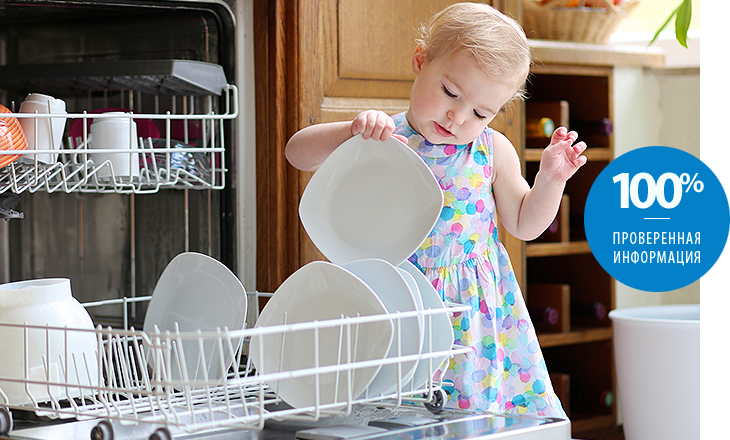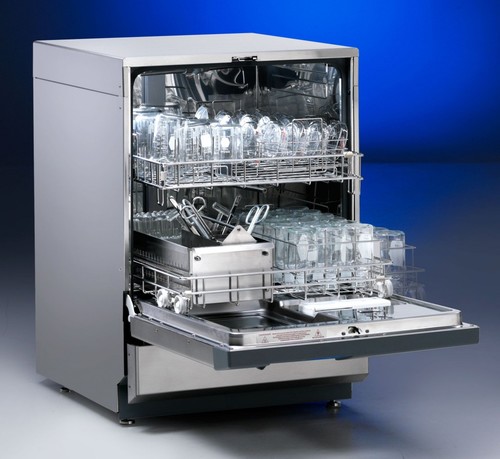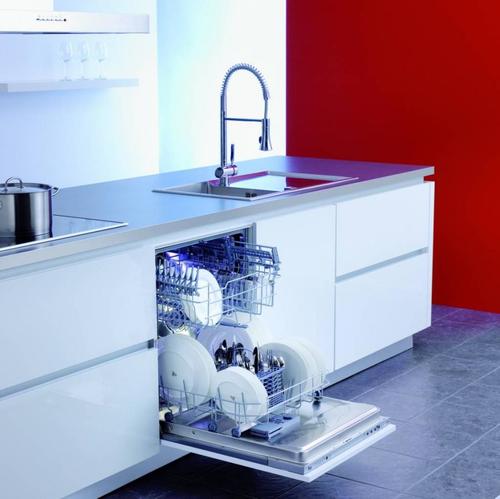
Modern dishwashers are economical, compact and multi-functional. They wash not only dishes and cutlery, but also clean the pots, pans, crystal, removable parts of kitchen appliances. After washing in the dishwasher, the dishes will shine from cleanliness, and there will be no trace of grease and pathogens.
Main rules of choice
Choosing a dishwasher is not easy, especially for those who do it for the first time. Many models, manufacturers, functions can turn the head even to the most experienced buyers. But, if you sort everything out on the shelves before coming to the store, choosing a dishwasher will turn into a real pleasure.
Sizes and dimensions of dishwashers
- Full size - accommodating up to 12-16 sets of dishes, and having the largest size - 60x60x85 cm.
- Narrow-sized - calculated on 6-9 sets and differing only 45 cm wide. Narrow dishwashers, as a rule, are designed for small families of 2-4 people, and are in the middle price category.
- Compact - allow you to wash up to 4-5 sets of dishes at a time. Their size is only 45x55x45 cm, so they can even fit in a miniature kitchen, although the efficiency of their washing is inferior to the previous two types.
type of instalation
According to the type of installation, all dishwashers can be divided into just two types: built-in and free-standing. In turn, embedded are divided into fully and partially embedded.
- Semi-built models They have an open panel, in contrast to the fully built panels, in which the panel is located at the top of the door.
- AT built-in dishwashers the top remains open. With this, you can perfectly fit the technique in the interior, covering it on top of the table top. In addition, the design of these machines allows you to hide the door behind a decorative panel, made of the same materials as the rest of the kitchen furniture.
- Separate cars with the same technical characteristics as the built-in car wash, they are much cheaper, and some models even suggest further embedding.
Class washing, drying and energy consumption
Dishwashers, like the rest of kitchen appliances, are divided into classes that determine the quality of washing, the degree of drying and the amount of electricity consumed. The higher these figures are, the better the dishwasher will wash, dry the dishes, while saving energy.
According to European standards, efficiency indicators in dishwashers have 7 classes, denoted by Latin letters A – G.
- Class A - impeccable cleanliness and high-quality drying of dishes. Dishwashers of this class are the most economical. The power consumption of this class of equipment is only 0.8-1.05 kW / h. In addition, they allow you to spend 30% less electricity, compared with kitchen appliances, having a lower class. In one complete washing cycle, up to 15 liters of water are consumed, unlike manual washing of the same amount of dishes, which would require at least 60 liters.
- Class B - the presence of minor stains or streaks on the dishes. B-class dishwashers are also considered economical because they have a moderate power consumption - from 1.06 to 1.09 kW / h.
- Class C - the presence of not washed fragments and drops of water. Models of this class have the highest power consumption - from 1.1 to 1.49 kW / h. But in the range of manufacturers such machines are extremely rare.
Dishwashing programs
A set of features that are present in almost all dishwashers:
- Prewash - rinsing food with a stream of cold water;
- the washing up - standard washing with a special detergent;
- Rinsing - rinsing with water washed dishes;
- Drying - hot air drying.
Expensive machines have even more advanced functionality: intensive washing at high temperatures, a program for washing fragile products at low temperatures, a quick wash to rinse "fresh" dishes, half load mode.

Other selection criteria
Drying
The technology of drying after washing dishes can also be different:
- Condensation - evaporates moisture from the surface of the washed dishes using the heat generated by the machine itself. This type of drying is the most economical, but impractical, since it requires time-consuming. In addition, after drying on the dishes may remain stains from water droplets.
- Turbosushka - found in expensive models. In this case, the dishes are blown by a fan and dry out much faster, and there are no traces of water on its surface.
Connection
Connect the dishwasher to the water supply in two ways: to cold or hot water. As a rule, all dishwashers should be connected to cold water, which is heated in the built-in tank during the washing process. Connecting directly to hot water will save energy, but when working at low temperature conditions, washing up can take some time.
Other selection criteria
Leakage protection
The Aqua-Stop function automatically closes the valve on the water hose. If the system works, the excess water will drain into the sewer. Not all models are equipped with this security system, so it is worthwhile to clarify whether this feature is present in the dishwasher, since it is differently referred to by each manufacturer.
Filters
In the dishwasher there is several filters. Their regular cleaning will provide excellent quality of washing without stains and stains. Some models are equipped with self-cleaning filters that fray residues of products, washing them into the drain. This will not clog the drainage system, which will increase the service life of the machine. In addition, the self-cleaning function saves water, thanks to its repeated use after filtration, and also reduces energy consumption for heating water.
Control
Modern dishwashers, as a rule, have a digital display that displays all the necessary information about the selected program and the end of washing. Certain controls can be hidden behind the door. Many dishwashers also have a child lock feature.
Most Popular Dishwasher Manufacturers
- The undoubted leaders among foreign manufacturers of dishwashers are: Bosch, AEG, ELECTROLUX, Gorenje, Siemens. Machines of these brands are the most reliable, but their cost is quite high, although each has a budget line.
- There are also manufacturers of premium-class appliances on the market, among them: Schulthess, Asko, Gaggenau. Their products are the most expensive, but at the same time, the highest quality. Most often, this technique is used for professional purposes.
- Dishwashers of such famous manufacturers as: LG, Samsung, Ardo, Hotpoint-ariston, Whirpool, Zanussi, Beko, Indesit. These brands have a wide model range and the best service support. Their pricing policy is quite flexible, and the models have a modern design and rich functionality.
- The cheapest equipment found in manufacturers Daewoo, Saturn, Kaiser, Delfa, West, Liberton. The disadvantages of dishwashers in this segment are frequent grinding, poor quality of washing, limited service life.

Common customer mistakes
- For the efficiency of the dishwasher are responsible such indicators as the class of drying and washing.Models with a Latin letter “A” on their markings can easily, quickly, and, most importantly, efficiently wash and dry dishes, but only if they give preference to a proven manufacturer.
- The internal surface of the dishwasher should be made of high-quality stainless steel, because, in addition to its excellent appearance, such a finish is easy to clean, has a strong coating, and is not afraid of heavy pots, pans and plates falling on it.
- Embedded technology is distinguished by the fact that it is hidden behind the outer panel. In addition, such machines usually work so quietly that it is almost impossible to determine if the wash cycle is over. Therefore, for owners of embedded technology, the presence of an indicator, in the form of a red beam on the floor, will be a very useful function.
